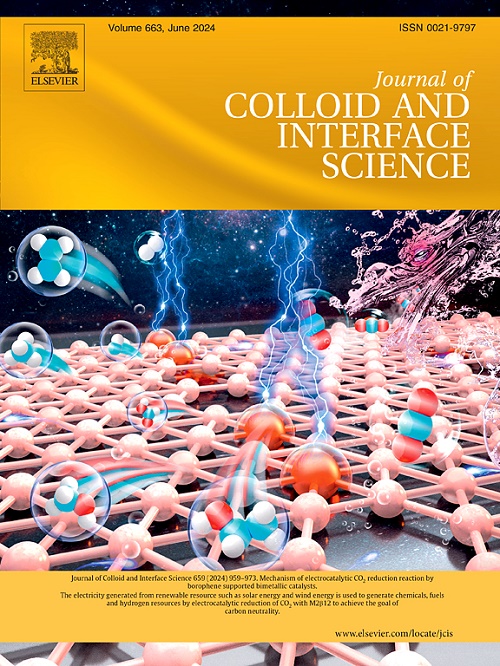为锂离子电池和固态锂电池设计并合成具有更强储锂性能的 FeS2/石墨夹层结构。
IF 9.4
1区 化学
Q1 CHEMISTRY, PHYSICAL
引用次数: 0
摘要
作为一种转换型阴极材料,FeS2 因其成本效益高、环境友好和理论容量大而成为下一代储能解决方案的理想候选材料。然而,一些挑战阻碍了它的实际应用,包括缓慢的动力学、绝缘反应产物和循环过程中显著的体积波动,这些因素共同影响了它的速率能力和循环稳定性。在此,我们采用氯化物插层和硫化策略,获得了一种精心设计的嵌入石墨层之间的 FeS2 夹层结构(FeS2/C)。层状石墨-FeS2-石墨结构增强了活性位点和对 Li+ 的吸附能力,从而保证了高可逆容量。此外,石墨碳基质还具有双重作用:既能增强电子导电性,又能在长时间循环过程中抑制 FeS2 的体积波动。这种组合可确保稳定的电化学动力学、结构完整性和较长的使用寿命。因此,FeS2/C 复合材料表现出卓越的锂存储性能,在 0.5 A/g 和 5.0 A/g 的条件下,容量分别达到 506.2 mAh g-1 和 277.2 mAh g-1。此外,FeS2/C 复合材料还显示出作为所有固态锂电池阴极的巨大潜力,在 0.1 A/g 条件下的第二次循环中显示出 658.0 mAh g-1 的高比容量,并且在 0.5 A/g 条件下循环 800 次后仍能保持 288.5 mAh g-1 的循环性能。这些数值超过了在 Fe2O3/C 复合材料上观察到的 96.1 mAh g-1 的第二次放电比容量和 25.3 mAh g-1 的循环容量。通过原位透射电子显微镜测试,进一步确定了 FeS2/C 复合材料的放电机制。这项研究为设计和合成 FeS2 提供了宝贵的见解,凸显了其在锂离子存储和所有固态锂电池方面的潜力。本文章由计算机程序翻译,如有差异,请以英文原文为准。

Design and synthesis of FeS2/graphite sandwich structure with enhanced lithium-storage performance for lithium-ion and solid-state lithium batteries
As a conversion-type cathode material, FeS2 emerges as a promising candidate for the next generation of energy storage solutions, attributed to its cost-effectiveness, environment-friendliness and high theoretical capacity. However, several challenges hinder its practical application, including sluggish kinetics, insulating reaction products and significant volume fluctuation during cycling, which collectively compromise its rate capability and cycle stability. Herein, a well-designed sandwich structure of FeS2 embedded between graphite layers (FeS2/C) is obtained using a chloride intercalation and sulfidation strategy. The layered graphite-FeS2-graphite configuration boosts the active sites and adsorption capacity of Li+, thereby guaranteeing a high reversible capacity. Furthermore, the graphitic carbon matrix serves a dual purpose: it enhances electronic conductivity and restrain the volume fluctuation of FeS2 during long cycling. This combination ensures robust electrochemical kinetics, structural integrity and long life. Consequently, the FeS2/C composites exhibit exceptional lithium storage performance, achieving capacities of 506.2 mAh g−1 at 0.5 A/g and 277.2 mAh g−1 at 5.0 A/g. Additionally, the FeS2/C composites show promising potential as cathodes for all solid-state lithium batteries, showcasing high specific capacities of 658.0 mAh g−1 at 0.1 A/g for the second cycle and maintaining a cycle performance of 288.5 mAh g−1 after 800 cycles at 0.5 A/g. These values surpass the second discharge specific capacity of 96.1 mAh g−1 and cycle capacity of 25.3 mAh g−1 observed for Fe2O3/C composites. The discharge mechanism of FeS2/C composites was further characterized through in-situ transmission electron microscope test. This work provides valuable insights for designing and synthesizing FeS2, highlighting its potential for lithium ion storage and all solid-state lithium batteries.
求助全文
通过发布文献求助,成功后即可免费获取论文全文。
去求助
来源期刊
CiteScore
16.10
自引率
7.10%
发文量
2568
审稿时长
2 months
期刊介绍:
The Journal of Colloid and Interface Science publishes original research findings on the fundamental principles of colloid and interface science, as well as innovative applications in various fields. The criteria for publication include impact, quality, novelty, and originality.
Emphasis:
The journal emphasizes fundamental scientific innovation within the following categories:
A.Colloidal Materials and Nanomaterials
B.Soft Colloidal and Self-Assembly Systems
C.Adsorption, Catalysis, and Electrochemistry
D.Interfacial Processes, Capillarity, and Wetting
E.Biomaterials and Nanomedicine
F.Energy Conversion and Storage, and Environmental Technologies

 求助内容:
求助内容: 应助结果提醒方式:
应助结果提醒方式:


